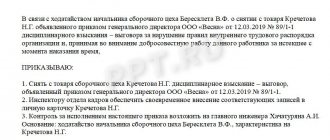Why do you need an explanatory note?
In the document flow, there are a lot of different documents, including an explanatory note. It is used to explain the reasons for certain situations, actions or facts. The paper is considered by law as a form of employee self-defense. And it is on the correctness of its composition and the logic of the presentation of facts that the subsequent decision of the management depends.
Often an explanatory note is required in the following situations:
- various emergency situations affecting production;
- various violations of labor discipline;
- violation of production discipline;
- various disciplinary offenses;
- misconduct.
In particular, most explanatory notes are drawn up due to being late for work or absenteeism, or failure to fulfill official obligations. Here is a sample out-of-office note:
The law prescribes
In Art. 57 of the Federal Law No. 90-FZ, Art. 192 and 193 of the Labor Code contain instructions that regulate the actions of the employer in requesting written explanations from employees who have committed unlawful acts and are guilty of not fulfilling their labor duties, violating labor discipline and labor regulations provided within the enterprise. Constitution of the Russian Federation in Art. 27 notes that the employee has the right to write an explanatory note, which cannot relate to the duty.
The measure of responsibility for the offense committed is classified as:
- remark, often made orally;
- a reprimand, depending on the aggravating circumstances, it is presented orally or in writing;
- dismissal from work with appropriate wording on the grounds specified in regulations and the Labor Code.
But, before exercising the right to impose a disciplinary sanction, the employer is obliged to request from the employee an explanation explaining the basis of his action, which led to violations of the rules of labor conduct, verbally or in writing.
A written explanation is used only in some cases, for example, if the validity of the reasons that formed the basis of his duty and led to a violation of labor discipline is assessed. In each specific case of an offense, it is necessary to carefully understand it, therefore the explanatory note argues for the details, explains the details of what was done and brings to the attention of management the employee’s opinion and his ability to analyze the current situation.
The number of personnel should be calculated based on feasibility. See how to create a staffing schedule for a construction organization.
The manager's reference for awards must contain positive information. Read more in the article.
Circumstances
The employee is obliged to explain the reasons that prompted him to commit this or that offense associated with failure to comply with the requirements for fulfilling official duties.
The circumstances are different, but they all lead to a certain type of violation of labor discipline and routine:
- being late for work for a good or bad reason, the reason must be clearly defined;
- failure to fulfill direct functional duties or their performance not in accordance with the requirements of the duties, for example, the work is performed poorly and therefore does not bring good results;
- absence from work during working hours without appropriate documents justifying his misconduct; a medical certificate certifying the employee’s illness can serve as an exculpatory document;
- damage to the employer’s property associated with negligence in the performance of work duties;
- failure to fulfill an order issued by the employer, which is not part of the direct duties of the employee;
- being at work in a state of intoxication from the influence of alcohol, drugs and toxic substances, which will entail failure to fulfill accepted obligations to comply with labor safety rules;
- failure to provide reliable information about the production activities of the enterprise to senior management, which leads to economic violations;
- in case of violation of life safety rules provided for at the enterprise.
Regardless of the circumstances, when an employee provides supporting documents attached to the explanatory note, the decision that is made in connection with the offense is mitigated.
According to the current laws and provisions of the Labor Code of the Russian Federation, only the employer has the right to request an explanatory note. He must hold the position of the head of the enterprise or a person authorized by the head, approved by order of the enterprise for a certain period.
The explanatory note helps the employer to find out the circumstances due to which the offense was committed and the degree of guilt of the employee. The employer, realistically assessing the situation, makes a decision on the appropriate disciplinary measure and the need to take it.
The employee has the right to refuse to write an explanatory note because it directly or indirectly confirms his guilt. But often the best option may be to provide an explanatory note to avoid more severe punishment in the form of fines or dismissal from work.
If he is not going to write it, he must notify the employer of the refusal. In any case, refusal to write an explanatory note is not considered an offense.
Notifying the employee to give an explanation
As already mentioned, the employer is obliged to request a written explanation from its employee before applying a disciplinary sanction (Article 193 of the Labor Code of the Russian Federation). In addition, there is a deadline within which an explanation must be given - two working days. Based on the fact that the legislator allocates a certain time, the employer must document the date when he asked his employee to provide a note. There is no mandatory requirement for this, but from a practical point of view such a document would be useful. Firstly, this is the starting date, and secondly, documentary evidence that the employee’s rights have not been violated. We give an example below to make it clear what should be indicated in it and how to write it. An explanatory note is requested on a letterhead signed by a representative from the employer, whose competence is to impose disciplinary sanctions. Typically, this is the manager or person to whom this authority has been delegated.
Also read: Characteristics for a driver from the place of work: sample, features of document preparation
When can you get fired?
Sometimes workers are interested in how many explanations are needed for dismissal. The answer is this: it’s not the number of such notes, but how management reacts to them. Management must request this document before applying disciplinary action to a subordinate (Article 193 of the Labor Code of the Russian Federation).
It is the presence of a disciplinary sanction against an employee who has repeatedly failed to fulfill his job duties that is one of the reasons for his dismissal. However, issuing an explanatory note does not always entail the imposition of “punishment” on the employee in the form of a reprimand or reprimand. And if the employer is satisfied with the employee’s explanations and does not apply any penalties to him, then any number of such papers can be written - this will not be a reason for dismissal at the initiative of the organization.
Legal significance of explanatory notes
Article No. 193 of the Labor Code (LC) of the Russian Federation obliges the manager, before making a decision on the degree of guilt and punishment of the employee, to receive his written explanations, which must certainly be taken into account in the process of the official investigation.
The explanatory note is endowed with great legal significance, because it allows:
- objectively and comprehensively assess the situation;
- identify those responsible for the incident;
- take measures to prevent a similar situation in the future;
- exclude further labor disputes based on misrepresentations of facts;
- it is fair to punish (or cancel the punishment) the guilty.
To provide the manager with a legally valuable document, it is necessary to comply with all the rules and regulations when preparing it. From a legal point of view, the note has no evidentiary value and is for informational purposes only.
When to write an explanatory note
There are certain deadlines for writing an explanatory note: no more than two working days from the date of the incident. That is why the employer, when drawing up a written request for explanations, must set a date - the report will be kept from this date. If an explanatory note is not written within the prescribed time, the employer has the right to apply to the subordinate any penalties adequate to the offense and within the framework of the law.
It should be remembered that only one disciplinary punishment can be applied for one violation and no later than a month after the fact of the violation is established (the fact is also established in writing, by drawing up and registering a special act).
Other cases when an explanatory note is required
Here are some formulations that will help employees justify themselves in similar situations. Don’t forget to format the documents as shown in the samples above: a header, the title of the document are required, and at the end - a personal signature and the date of preparation.
Failure to fulfill duties
On 10/09/2019, I did not complete the mandatory walk around the warehouse at 10:00 p.m. because I suddenly felt unwell and had an attack of hypertension.
I can confirm this fact by the presence of an ambulance call on my cell phone at that time.
Explanatory note regarding the violations identified
On 10/09/2019, I made a mistake when filling out the work book of the dismissed employee N.E. Sotkin. due to inattention, amendments were made to the work book in accordance with the legislation of the Russian Federation.
Loss of documents
On 10/09/2019, I lost unsigned advance payment slips and payslips; while traveling from the post office to the office, I forgot them in a taxi. The documents could not be returned; they were restored.
Document delay
On 10/09/2019, I delayed the inventory of materials, since their completion required an additional working day. At the moment, the inventory has been drawn up by the storekeeper, signed by me and handed over to the manager.
Required details
The explanatory note, like any other document, must indicate a number of details.
Also read: Travel certificate cancelled: resolution, when it was cancelled, how to apply for a business trip in a new way
These include:
- name of the organization, structural unit;
- the addressee, often the head of the organization;
- addressee, that is, the direct violator;
- name of the document type;
- registration number. Indicated in the HR department upon registration;
- document text;
- date of writing;
- compiler's signature.
If you take into account all the listed details, after writing you will get a document similar to this:
How to correctly write an explanatory note in 2021
An explanatory note is a document drawn up in writing, the author of which provides explanations about an event or fact that happened to him or to those for whom he is responsible.
The paper is drawn up in handwritten or printed form, submitted voluntarily or upon request. Write on a blank A4 .
The explanatory template is used to compose it properly. For example, it is worth looking at a sample explanatory note about an error in work. The structure of such evidence is subject to requirements accepted in office work.
Step 1
The preparation of the explanatory note begins with the preparation of the “header” of the document, placed at the top right.
1. First, provide the details of the recipient. Position, surname, initials are written in detail . The dative case is used.
An example of the first part of an explanatory header for the director: (to whom?).
Director of LLC "Pervy" Ivanov I.I.
2. Indicate the data of the compiler , including position (social status). The full name must be signed in full and put in the genitive case:
(from whom?) From 4th category mechanic of the construction site Ivan Denisovich Petrov;
(from whom?) Marina Georgievna Petrova, mother of Sergei Ivanovich Petrov.
Leave contact information: phone number, e-mail.
Step 2
Below the “header” they make a small digression (3-4 lines) . “Explanatory note” is written in capital letters in the center of the sheet. The next line indicates the reason for issuing the paper: due to the lack of full name and date of the injury received at school. The inscription is placed in the center.
Step 3
If you look at any sample of an explanatory note, for example, about an error in work , you can see that the explanatory part is conditionally divided into two.
First, the incident (essence, situation, time period, place, participants). Then they tell why this happened.
Step 4
At the end of the explanatory note, in one line, put the date (along the left edge) of its composition and, making a slight indent to the right, the signature, initials and surname of the author.
sample explanatory note
Step 5
Such papers are in some cases accompanied by attachments confirming the accuracy of the above information. Attached:
- certified medical forms;
- certificates of visits to government institutions (from court, traffic police);
- acts (on accidents, road repairs);
- excerpts from media articles confirming events, etc.
It is advisable to provide copies of documents certified by the secretary. The originals may be required for defense in court.
What happens if an employee refuses to write an explanatory note?
The subordinate has the right to refuse to provide explanations, and no punishment or DV is provided for this. Management does not have the right to force or force a subordinate to draw up a note. However, such resistance does not relieve the employee from liability for an “unexplained” violation.
In such a case, the manager draws up a report on the employee’s refusal to provide written explanations, signed by two witnesses.
So, requesting an explanatory note is the responsibility of the manager; writing or refusing to write it is the employee’s right. Refusal in no way can be regarded as a disciplinary offense or a violation of the Labor Code.
It is possible to refuse to draw up a document, but it is not entirely reasonable. Hiding your “head in the sand” will not solve the problem, and there is a high probability of the situation getting worse.
Proud silence in this case can be regarded as if the employee committed the offense intentionally and intentionally due to his obstinate nature. Explanations with attached evidence of innocence or good reasons will help smooth out the situation and avoid penalties.
If relations are strained to the limit and a conflict has flared up, both parties are advised to secure their position. It is advisable for the employer to draw up a written request for explanations, and for the subordinate to provide them on time; it is advisable to endorse or register the second copy and keep it for yourself.
Certificate of refusal
In a situation where an employee categorically refuses to write an explanation, an act is drawn up based on this fact. The correct execution of this document determines the degree of its legal significance.
When drawing up an act, a special form is used, adopted by the enterprise or established by the requirements of GOST.
Certain details are required to be specified:
- Name of the organization.
- Correct title (type and name of the document).
- Date and place of compilation.
- Document registration number.
- Signatures of the head, two members of the commission drawing up the act.
- Approval stamp (only if necessary).
The document must indicate the violation that the employee refused to explain and the reasons for the refusal. An employee who does not want to explain must read the document against signature.
Also read: Employment contract with a remote worker: sample and design features
The employee has two working days to provide the note, and only after their expiration can a statement of refusal to provide explanations be drawn up.
An explanatory note is not a death sentence and indisputable evidence of guilt. When writing it, it is worth calling on all possible gifts of persuasion in your rightness or repentance, and most likely the “storm clouds” over the workplace will happily dissipate, which is what we all wish for.
How to write correctly to avoid punishment

Most of the success when writing an explanatory note depends on its correct composition ; for this you need to follow several rules :
- avoid a large amount of unnecessary information and lengthy narratives; the information should contain useful information that explains the situation;
- do not use eloquent phrases that insult or, conversely, extol the other party who took part in the situation;
- do not hide the truth and do not shift your guilt onto anyone; a sincere confession is more conducive to oneself;
- Avoid grammatical and spelling errors and blots in the explanatory note; it must be written on a clean white sheet of paper, in neat and legible handwriting; the document should not cause irritation just by its appearance.
Explanatory note to school
Such a document may be needed at school due to the child's absence from classes without prior notice or if the parents did not attend the meeting. The document is drawn up by hand, it contains standard data: the addressee of the appeal, date and place of writing, data of the originator, explanations given and signature.
A distinctive feature of this type of explanatory statement is that it is drawn up not by the truant child, but by his parents.
An example of such a document is given here:
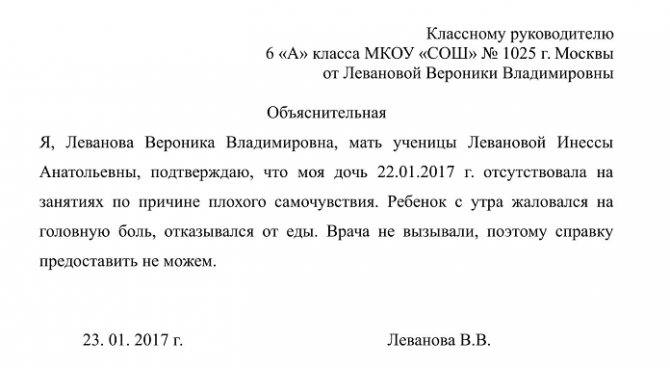
Explanatory note to the institute
This type of document is drawn up by the student addressed to the dean of the faculty where he is studying. In addition to standard information, the document must additionally indicate the number of school days missed, indicate the dates and reason for absence. If there is a supporting document (for example, a medical certificate), it must be attached to the explanation.
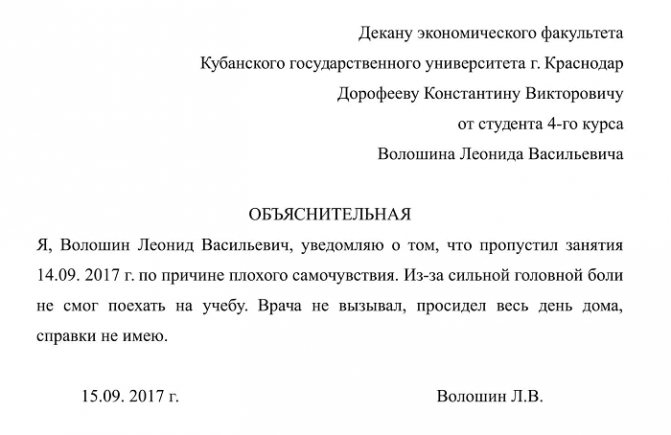
Explanatory note for work
This type of explanatory note is the most common and is drawn up before management makes a decision on disciplinary action.
Also read: How to restore a work book if lost on your own or through government agencies
It can be issued as an explanation for one’s absence or failure to fulfill official duties. In the second case, the explanatory note is part of the main document.
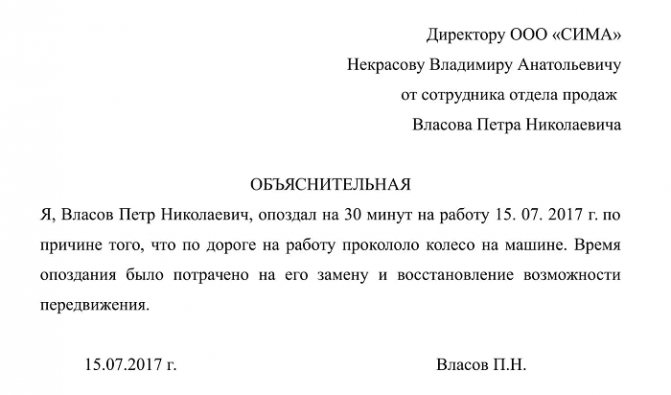
How to write an explanatory note at work for failure to fulfill official duties
The Labor Code stipulates that the form of the document must be written, but the legislator has not provided anywhere either a sample, or the procedure for its preparation, or instructions.
It is allowed that an organization can, by local regulations, develop its own form of explanatory note, but if there is none, the explanatory note is written in free form.
Important! The note should include the following information:
- Full name of the addressee indicating his position and department.
- Date and document number (if registered in a special journal of outgoing documentation of the department).
- The text must describe in as much detail as possible all the circumstances of the incident, indicating the persons involved. Of course, you should not shift all responsibility onto your colleagues, but if the circumstances have developed in such a way that the employee is not to blame for the consequences that have occurred, you should not admit your guilt.
- Signature, its transcript and the position of the author of the note.
It is recommended that the explanatory note be given to the person or department who registers incoming correspondence in order to once again protect yourself from illegal actions of the employer.
Explanatory note (sample) about an error in work
Now let’s look at a case where it’s much harder to make excuses. Porfiry Zhuchkov forgot to turn off the lights in the office before leaving home. As a result, the light bulb burned out.
The form of this type of document is similar, with the exception of attachments. But on the third point we will give some explanations:
- Zhuchkov must state the essence of his mistake and its reasons.
- It is recommended to mention the consequences as well. This way the manager will see that the employee is assessing the situation soberly.
- The mistake should be admitted and the blame should not be shifted to others. But objective circumstances, if any, can be cited.
- In conclusion, it is good to note that this will not happen again.
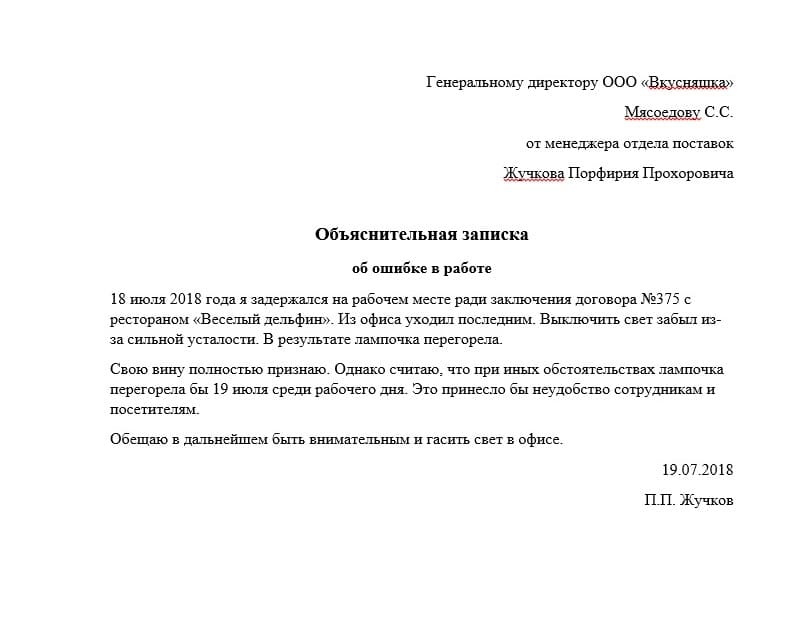
Explanatory note to the police
There are situations when explanations have to be written to the police. Such a need may arise in the following cases:
- Calling the squad, who has to give written assurance that there was a response to the call.
- Committing unlawful acts against the applicant, who explains what exactly happened.
- Execution of a document by the offender, which explains where he was and what he was doing at a certain point in time.
The document contains standard information about the recipient of the explanatory note, the originator, the essence of the document, the date of execution and signature. A sample can be viewed here.

Explanatory note to the tax service
Each reporting period, the organization must submit the necessary information to the tax service; this can happen in the following cases:
- failure to submit a tax return to the service on time;
- identifying errors in the declaration when writing words or numbers;
- discrepancies between the data available to the tax office and those submitted by the organization.
The explanatory note is attached to the amended declaration and can be submitted either in person or sent by mail. It needs to answer in detail, but not in a very large volume, the questions that the tax inspector has, for example, why this final figure was obtained, methods for calculating taxes, or for what reason errors were made.
Example:
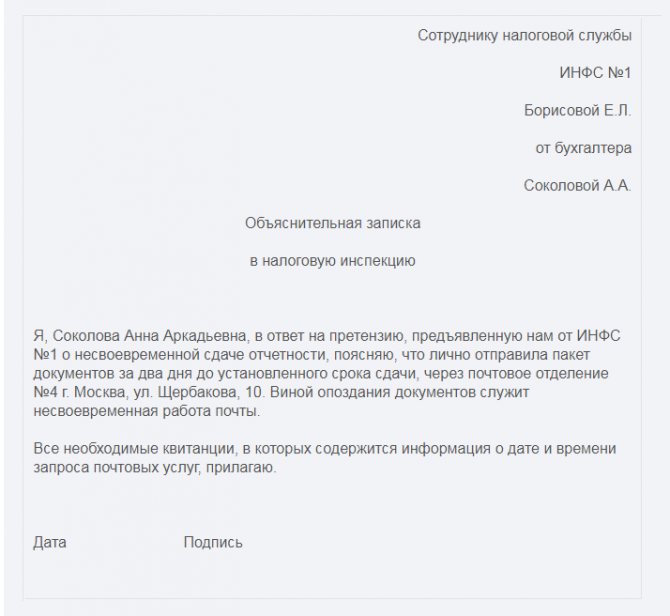
Explanatory note from the cashier
The work of a cashier is very responsible, as it is carried out in close contact with funds. Therefore, every erroneous action must be accompanied by an explanation and, if possible, evidence attached to it. A note is drawn up in the following cases:
- when a check is bounced for the wrong amount;
- making returns on a receipt tape;
- incorrect calculation, which resulted in a shortage or surplus of funds in the cash register;
- improper maintenance of cash documents.
Also read: Employment contract with a remote worker: sample and design features
The main part of the explanatory statement indicates the date of the error, the incorrect amount, the difference in data, check numbers, and the reason for this action. You can also indicate whether it was corrected and in what way. Afterwards, confirmation receipts with the cashier’s signatures, if any, are attached.
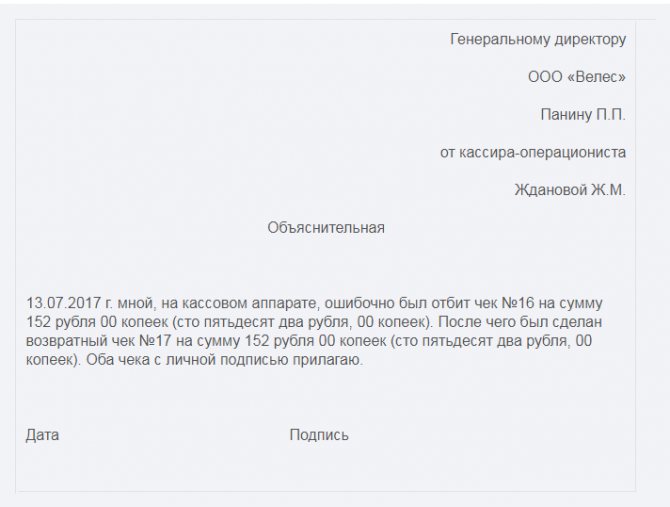
Explanatory note in kindergarten
Parents usually write explanations to kindergarten in cases where the child missed several days, but not because of sick leave, or did not visit a doctor, but was treated by the parents themselves.
The note is written not in the name of the teacher, but in the name of the director of the kindergarten. It indicates the child’s name, how many days he missed, what dates they fell on and the reason for the child’s absence.
Example:

To whom should the explanatory note be addressed?
In small organizations, the addressee is the manager, in large enterprises - the direct superior.
An explanatory note regarding an injury received by a child (schoolchild, kindergarten student) is written to the director or head of the institution. If a student is injured, the addressee is the head of the college or university. In all these cases, a typical explanatory letter from the teacher for the head of the kindergarten is suitable, a sample of which should be used.
Material on the topic: How to write a business plan: ready-made instructions, structure and sample
The explanatory note has been drawn up, what next?
The employer, having received the explanatory note, puts on it the registration number of the incoming document and, without fail, the date of reception.
According to Art. 193 of the Labor Code of the Russian Federation, which we referred to at the beginning, the employee has 2 working days to write an explanatory note. If after this time the employee does not provide an explanation, the employer has the right to draw up an appropriate act about this. In order to insure against unlawful actions on the part of the employer, it is better for the employee to register his explanatory note in the office or with the secretary with an appropriate mark on the document, and then pick up a copy of the explanatory note with this mark. Another option: the employee can write an explanatory note in 2 copies, and keep one of them, after marking the acceptance. Then no one will be able to say that the employee did not provide written explanations within the period established by law.
Only his employer (as a rule, represented by the general director) has the right to impose a disciplinary sanction on an employee. He formalizes his decision in the form of a resolution. If the manager decides to punish the offender, then subsequent documents are drawn up on the basis of such a resolution (for example, an order of dismissal, etc.).
The order of design and content of the text
A single form for writing this document is not approved by law, so companies use internal forms. If we talk about whether to issue it by hand or on a computer, then both options will be correct. However, some employers require handwritten evidence of what happened from their employees.
This is due to the fact that if the case goes to court, it will be impossible to challenge the authorship of the note. If it is compiled on a computer, then it will be either difficult or even impossible for a graphological examination to determine the authenticity of the document based on one signature. In this case, the employee can challenge the text, claiming that he signed it under duress.
To avoid such labor disputes, it is advisable to indicate in the printed text by hand:
- full first name, last name and patronymic,
- personal signature,
- employee's job title.
Like all business correspondence, the note has some mandatory design standards. The structure of the document might look like this:
- A cap.
- Name.
- Main text.
- Date and signature.
The text is located in the upper right corner of the document. First, the name of the addressee is indicated, i.e. position, and in the next lines - the person’s full last name, first name and patronymic. The third line contains the name of the compiler (position), and the fourth line contains his full last name, first name and patronymic. In this case, according to the rules of a business letter, the preposition “from” can be omitted.
In this case, an “Explanatory Note” is placed. If the text was typed on a computer, then the name is written in all capital letters without a period at the end. If the text is handwritten, the title begins with a capital letter and continues with lowercase letters. There is no period at the end. The title is located in the center of the sheet immediately below the header.
Here the culprit of the events describes everything that happened in the first person. There are no restrictions or rules on exactly how the text should be composed. However, it should be remembered that this is a business document, so it is important to adhere to correctness in wording and avoid any colloquial language, accusations and unsubstantiated statements.
It is important to present the events as accurately as possible. If the employee’s guilt is obvious, then in no case should you deny it or shield yourself in any way.
When drawing up an explanatory statement, the employee can attach any other documents indicating his innocence. For example, if you are late for work, you can provide a printed diagram of train delays or news from the city portal about disruptions in public transport.
If it is not the employee who is to blame for the loss of property, but there has been theft, then any witness statements or a statement to the police must also be presented.
Even the most ordinary quarrel between colleagues can be presented in a light favorable to the culprit if it is possible to collect any evidence of the legality of his actions (written or oral).
The date is placed in the lower left corner of the document, and the signature is placed opposite to the right. Below the personal autograph is a transcript.
We invite you to familiarize yourself with: Receipt for receipt of child support
It is important to ensure that the note is accepted against signature indicating the date and position of the employee who received it.
If an employee does not agree with management’s decision, he can challenge its actions in the following instances:
- Labour Inspectorate,
- prosecutor's office,
- court.
Or convene a labor dispute commission within the enterprise and consider the case. In difficult situations, the employee needs to provide all the documents, and most importantly, provide reasoned written data in his defense.







